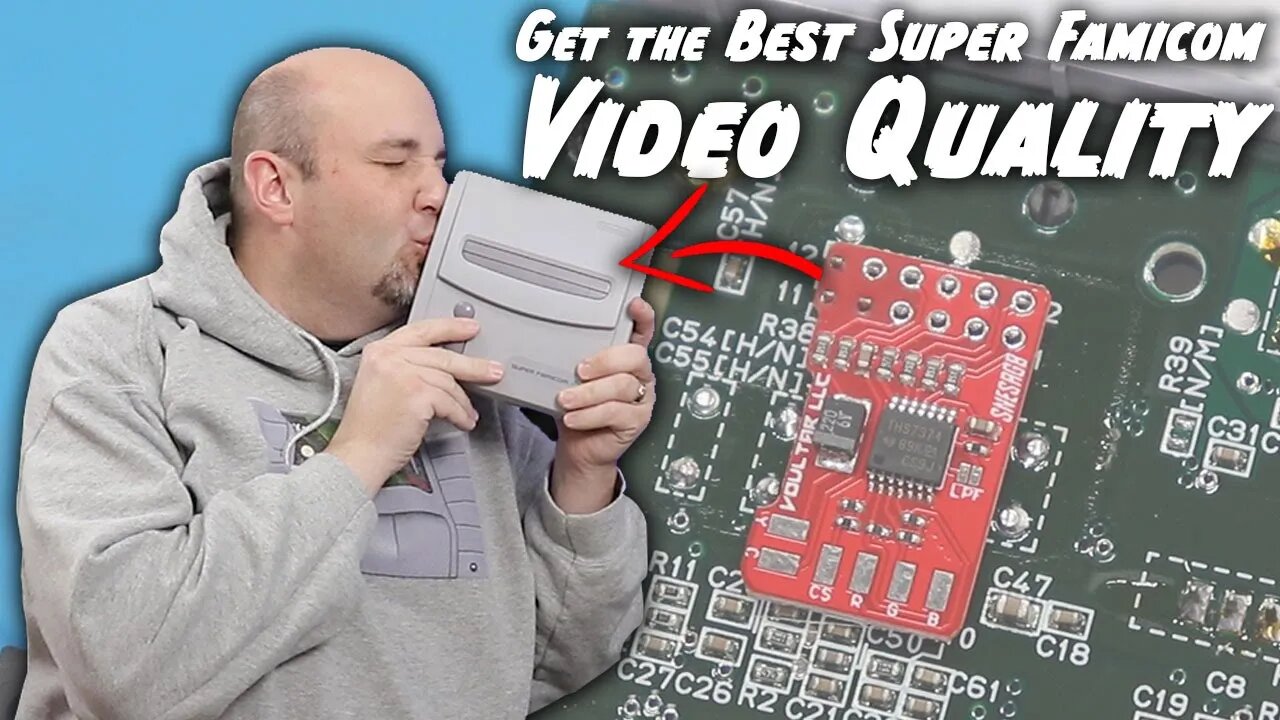Premium Only Content

Get the Best Super Famicom Jr Video Quality with Voultar's RGB Mod
In this episode, I walk you through the steps that I followed to upgrade my Super Famicom Jr to RGB SCART output using Voultar's RGB board.
0:00 - Introduction
3:26 - Composite Video Example
4:51 - Disassembly
9:27 - PCB Overview
12:12 - Tacking the Board Into Place
14:07 - Prepping Wires
16:37 - Soldering to the Vias
18:04 - Soldering the wires to the Board
19:40 - Removing C11 Capacitor
20:48 - Soldering New C11 Capacitor
21:27 - Cleaning Up the Board
21:58 - Reassembly
23:59 - Results Comparison
25:32 - Final Thoughts
When I got back into collecting retro games, I did so with a Hyperkin Retron 5. One of my favorite things about that system was the fact it allowed me to discover the money savings that can be found importing Japanese Famicom and Super Famicom games. For many of the games that I like to play, action platformers, puzzle games, racing games, there's no language barrier. That makes it less expensive for me to play the games that I love compared to the US counterparts. As time has gone on, I have retired my Retron 5, instead opting to go with original equipment. I love the Super Famicom, but much like the Super Nintendo, the Super Famicom Jr actually provides better video output than the original. Well, that is after you mod it. To save money, Nintendo removed the RGB output from the Super Famicom Jr, but thanks to Voultar, we can restore that functionality, and the results are stunning.
I bought the system at the Bloomington/Normal Games Con in April of 2021, and this was the first time I had a chance to look inside the case. I was thrilled! This system was super clean, something I always like to see. I had ordered the RGB mod kit from Voultar, and it arrived within 2 to 3 days. With it on the bench it was time to get to work.
One of the things about these mods is they can go stupid easy, or the dumbest issues can crop up. For some reason, I just could not get a clean solder joint on the leads going from the vias on the board. They just did not want to cooperate. I don't know if it was me being tired, my soldering iron tip needing to be cleaned more than what I was doing, or what, but soldering the leads to the vias was a pain in the ass.
In addition to the RGB mod itself, I also replaced the C11 surface mount capacitor on the board. Often referred to as the ghosting capacitor fix, this is something you can do even if you don't RGB mod your system. As the name implies, upgrading this capacitor eliminates ghosting from images on your display. The beautiful thing is that this capacitor is not polarized so you don't have to worry about positive or negative. Removing the old capacitor is super easy, but due to the small size it can be slightly challenging to solder the new capacitor on the board. Be careful, capacitors do not like heat and it is possible to overheat and damage your new component.
Hooking up the system with HD Retrovision cables and my RetroTink 2x pro, I was thrilled with the results. Looking at the footage captured, it looked a little bit on the dark side but there is an easy fix. HD Retrovision cables have an inline brightness switch, and once I flipped that switch the brightness was correct on my captured footage. As I was finishing the edits to this video, the news broke about the RetroTink 5X, and I cannot wait to run this system through that beautiful piece of hardware.
I love the Super Famicom, and now having a Super Famicom Jr in my collection is that much more awesome. The color, the sound, the performance of the SFC Jr blows away the standard Super Famicom in my opinion. And one of the best things about this mod is you can't tell that anything has been done to the system from the outside, and it retains all of the systems original composite video functionality. I'm thrilled with these results, and I hope you are as well.
#SuperFamicom #ImportGames #VoultarMod
The footage used in this review are used under the Fair Use laws, referenced below:
https://www.law.cornell.edu/uscode/text/17/107
Notwithstanding the provisions of sections 106 and 106A, the fair use of a copyrighted work, including such use by reproduction in copies or phonorecords or by any other means specified by that section, for purposes such as criticism, comment, news reporting, teaching (including multiple copies for classroom use), scholarship, or research, is not an infringement of copyright.
(Pub. L. 94–553, title I, § 101, Oct. 19, 1976, 90 Stat. 2546; Pub. L. 101–650, title VI, § 607, Dec. 1, 1990, 104 Stat. 5132; Pub. L. 102–492, Oct. 24, 1992, 106 Stat. 3145.)
-
 14:17
14:17
RoXolidProductions
21 days agoThe BEST Xbox 360 Controller? Retro Fighters Hunter 360 Wireless Review
1101 -
 UPCOMING
UPCOMING
Nerdrotic
35 minutes agoWB Sale is Hollywood's DOOM! | Stranger Things REVIEW | BBC Get's F*%#@! - Friday Night Tights 382
-
 49:45
49:45
Liberty Hangout
1 day agoThe Left HATES America and Can't Change My Mind!
43.6K71 -
 23:42
23:42
The Kevin Trudeau Show Limitless
2 days agoThe Brotherhood’s Ancient Mirror Code Revealed
21.9K10 -
 10:18
10:18
Colion Noir
3 hours agoViral TikTok Proves Gun Owners Wrong?
22.3K29 -
![MAHA News [11.28]](https://1a-1791.com/video/fwe2/11/s8/1/O/6/L/D/O6LDz.0kob-small-MAHA-News-11.28.jpg) UPCOMING
UPCOMING
Badlands Media
14 hours agoMAHA News [11.28]
7.57K1 -
 1:01:18
1:01:18
DeVory Darkins
3 hours agoBREAKING: Trump issues fatal update to National Guard shooting
104K63 -
 49:57
49:57
The Quartering
2 hours agoTrump UNLOADS, Walmart Black Friday Madness & Trans Taco Bell Attack
17K28 -
 39:51
39:51
Tucker Carlson
2 hours agoGeorge Galloway Speaks Out on Being Forced Into Exile After Criticizing Ukraine War
27.8K82 -
 21:23
21:23
Neil McCoy-Ward
1 hour ago🔥 While You're Working Hard... They're Planning To Take EVERYTHING From You!!!
6.15K2